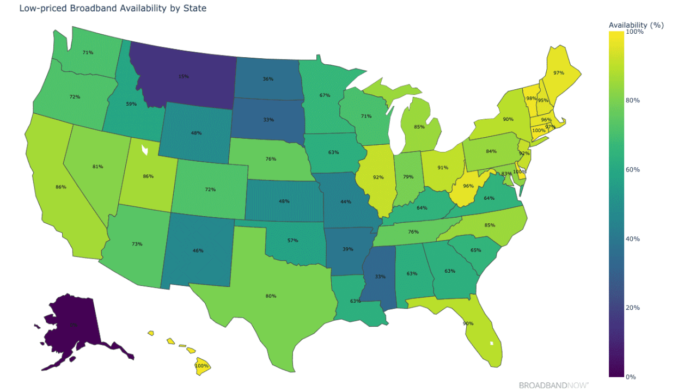Every few years, BroadbandNow dives into the cost of internet plans across 2,000 US-based ISPs and how they compare to the median incomes of households across all 50 states plus the District of Columbia. This year, it’s again checking who in America has broadband—defined as a connection with a minimum of 25Mbps for downloads and 3Mbps for uploads—and how many can get it for less than $50 per month.
The answer is still: not everyone. And that’s not good enough.
The data clearly show that prices are down for higher-income areas (probably because of increased competition in densely populated regions) and that in 10 states, less than half the population can get service costing lower than $50 a month: Mississippi, Arkansas, Missouri, New Mexico, Montana, Kansas, South Dakota, North Dakota, Alaska, and Wyoming.
Only four areas—Delaware, Hawaii, Connecticut, and Washington D.C.—have hit 100% availability, as outlined in the map above.
BroadbandNow also published the graph below, which shows low-priced broadband coverage on the vertical Y-axis and median household income on the X-axis. States in the lower left tend to get the shaft from broadband providers when it comes to pricing. Compare Mississippi, with only 33% of its population able to get $50 broadband, with D.C. and Connecticut. Residents in the latter have median household incomes closer to $100,000 a year, and 100% can get broadband for less than $50 per month.
(Credit: Broadband Now)
The report goes on to say that, of course, income is far from the only factor in broadband affordability. And governmental steps are being taken to close the gap.
For instance, the Affordable Connectivity Program offers discounts on broadband to low-income Americans. As part of the program, the White House got 20 ISPs to offer “free” 100Mbps connections to qualifying households. You can apply at affordableconnectivity.gov(Opens in a new window).
Recommended by Our Editors
Also, the Broadband Equity, Access, and Deployment (BEAD(Opens in a new window)) grants allocate $42.45 million to states and territories to build out broadband. All states have received their planning funds(Opens in a new window); now we wait to see what the plans actually are. Part of that involves new maps from the FCC that don’t just take the ISPs’ word for it on where they provide service—in the past, entire census tracts were marked “served” when they had little to no broadband from a listed provider. The maps will help with targeting the funds, but only if they’re accurate.
For more, read the full report at BroadbandNow(Opens in a new window).
 12 Tips to Troubleshoot Your Internet Connection
12 Tips to Troubleshoot Your Internet Connection
Get Our Best Stories!
Sign up for What’s New Now to get our top stories delivered to your inbox every morning.
This newsletter may contain advertising, deals, or affiliate links. Subscribing to a newsletter indicates your consent to our Terms of Use and Privacy Policy. You may unsubscribe from the newsletters at any time.
Hits: 0
















